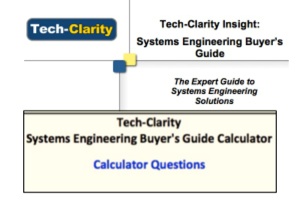 Tech-Clarity’s Systems Engineering Buyer’s Guide helps manufacturers develop criteria to evaluate software solutions to support Systems Engineering on a set of high level criteria. Tech-Clarity’s Buyer’s Guides go beyond software functionality to provide a framework of requirements that impact implementation success and long-term ROI, including:
Tech-Clarity’s Systems Engineering Buyer’s Guide helps manufacturers develop criteria to evaluate software solutions to support Systems Engineering on a set of high level criteria. Tech-Clarity’s Buyer’s Guides go beyond software functionality to provide a framework of requirements that impact implementation success and long-term ROI, including:
- Software capabilities
- Implementation
- User adoption
- Support
- Vendor characteristics / attributes
- Industry or unique business needs
Please enjoy the summary below, or click the report to download a PDF overview (free of charge, no registration required).
For the full report, please visit our sponsor, PTC, here (free of charge, registration required).
****Update: To help companies prioritize and identify where to focus first, Tech-Clarity has developed an interactive assessment based on our Systems Engineering Buyer’s Guide. The assessment asks where you have the most trouble as well as your company’s current capabilities. It then uses your responses to recommend the top three areas of systems engineering you should look at first.
an interactive assessment based on our Systems Engineering Buyer’s Guide. The assessment asks where you have the most trouble as well as your company’s current capabilities. It then uses your responses to recommend the top three areas of systems engineering you should look at first.
To download this interactive assessment please visit our sponsor, PTC, here (free of charge, registration required) and receive personalized recommendations to help you prioritize buying criteria based on your company’s needs.
Table of Contents
- Executive Overview
- The Business Value of Systems Engineering
- Start with Process Definition
- Manage Requirements
- Design the System
- Design the System to Be Modular
- Support Product Line Variants
- Enable Detailed Design
- Verify and Validate the System
- Assess Service Requirements
- Consider Vendor Attributes
- Identify Specific Needs for your Company
- Conclusion
- Recommendations
- About the Author
Executive Overview
In today’s world, fierce global competition is driving companies to seek new ways to competitively differentiate their products. Many companies are incorporating embedded software into their products to set their products apart from the competition. Embedded software offers opportunities to incorporate intelligence into a product as well as offer customers a more personalized experience. The Internet of Things (IoT) takes this even further by creating exciting possibilities for new and differentiated services for products with smart, connected devices. However, taking advantage of this requires expert systems engineering practices.
While bringing together mechanical components, electronics, and software presents exciting opportunities for innovation, it also brings unique challenges and adds new levels of complexity to today’s products and product development processes. Consequently, expert systems engineering practices are critical to the success of today’s products. A key part of implementing expert systems engineering practices is having the technology to support them. This buyer’s guide will help manufacturers select the right software to support systems engineering.
This guide is composed of four major sections covering, systems engineering software tool functionality, service requirements, vendor attributes, and special company considerations (Figure 1). Each section includes a checklist with key requirements to investigate when selecting software tools to support systems engineering.
To set the foundation for expert systems engineering practices, companies should focus on the entire systems engineering process, ensuring there are solutions for all aspects of systems engineering. This will enable companies to be even more competitive in ways that will lead to higher growth and greater profitability.
This guide is not an all-encompassing requirements list. It provides a high level overview for systems engineering. In addition to the systems engineering capabilities discussed in this buyer’s guide, companies should also consider needs for the tools of individual engineers for each engineering discipline.


